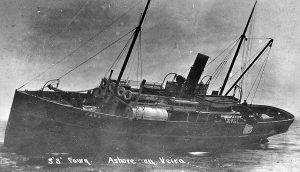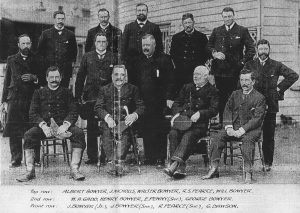“SS Fawn”, the Bowyer’s, and the nuns, 1870
This is a story of a steamship, a Carmelite community of sisters, an extended family of Southampton pilots and a German ship-builder, in late 19th Century Southampton and Sussex, Normandy, Kiel, and the Orkneys.
This is a sketch of what I think I know so far about a small steamship, SS Fawn (Official Number 62212), built in Kiel in 1869, her ownership by an extended Southampton port family, and her use to transport a party of nuns in 1870 from France to England. I hope you will agree that the stories of the ship, its owners and skippers, the nuns’ journey and the destination are all fascinating. All further or better information, hugely welcome.
The background
In 1870 a Carmelite community of nuns in France sought to return to the country where it originated: England. The sisters had planned a leisurely move to a new purpose-built monastery being prepared for them near Chichester. In the event, German successes in the Franco-German war made them fear that their erstwhile home in Normandy might be over-run.
The Carmelites’s own story of their community says they chartered a steamer called “Fawn”, of Southampton. The only remotely likely ship I can find was a very small, very modern screw-ship from a Southampton firm, and it loaded and carried the nuns and their gear, including the convent bell, from Cherbourg to Dell Quay, the tiny, beautiful, historic port of the historic city.
The ship’s origins
A man called James T Bowyer (I surmise it is the Bowyer of that name, born c1814, and still alive in 1902; and sometimes written as Jas or J Bowyer Snr), a scion of a family of Southampton pilots and small-time ship-owners, is listed as commissioning SS Fawn to be built by Georg Howaldt (1841-1901) of Kiel. Some time before 1875 James transferred her to the recently-incorporated Southampton New Steam Towing Company, which was managed by Edward E Andrews, who was one of his sons-in-law (having married James’s daughter Jessy in 1862). Fawn may have been one of the first powered pilot boats; her role in towing sailing ships in and out of port was more normal (as in Turner’s famous Temeraire), though she may have been one of the first screw-driven vessels to be a tug.
The German side of the story which follows comes to me, very generously, from Dr Christian Ostersehlte, the historian of German ship-building, and parts of it can be followed online. (I will write up Dr Ostersehlte’s fuller account separately.)
Georg came from a ship-building family and had also trained at Summers & Day, a ship-builder in Southampton, where – I presume – he met and married James’s daughter Esther (Esther Emily Bowyer, born 1843) in 1866. In the next eight years, she bore him five of his 12 children, dying in 1874, five months after her last was born.
This was a period when German ship-builders admired British technology (and indeed Howaldt ordered a Summers & Day crane for his yard), though the Germans caught up by the 1890s and were within a few decades to add relative cheapness to technical ability. Nonetheless, SS Fawn remained a rare – perhaps a unique – example of a German ship flying the Red Ensign. Fawn’s Yard Number was 11, so she was one of the first ships the family firm Howaldtswerke built and was quite similar in hull and superstructure shape to the first, the Vorwärts (“Forward”).
I have the untutored impression that SS Fawn and SS Vorwärts share a Baltic sort of shape, rather than a British one. Oddly enough, whilst in Visby, on Sweden’s heavenly Gotland, I came across a painting in a museum – or more certainly bought a postcard of a paiting – of Ångfartyget (ferry) Klintehamn, built in 1876, and 37 metres long. She’s bigger and somehow more modern than our SS Fawn, but may halp make a case about a certain Baltic quality shared between them.
When the little ship (91 feet long) arrived in Southampton, her first Master was James’s son William C Bowyer (1846-1919), William was a registered Trinity House pilot at the time. I know little of him except that he owned and raced yachts, perhaps a natural sport in a profession which sailed fast, owner-managed cutters in a competition to get pilots to potential charges in the open sea. William (who seems also to be known as Will) later owned Ianthina, a little cutter – a gentleman’s racing yacht – built by Stow of Shoreham, a distinguished yard.
In the year of the nuns’ voyage, Fawn was commanded either by Robert C Mable, of whom I have found nothing yet, or more likely by George Dawson. George was probably born in 1831 and may have died in 1879. He married a woman 15 years his senior called Mary; fathered a son, George Henry (born 1860), who became a Southampton pilot; and in 1870, around the time he skippered Fawn, both father and son lived in Paget Street, and later at Princes Street, Southampton.
The Carmelites
In 1870, her first full year in Southampton, Fawn was chartered by a party of Carmelite nuns from an exiled community originating in 17th Century England (expatriate might be a more accurate word). They had a few decades before settled in a re-purposed stately home in Valognes, Normandy, but a bequest had enabled them to think of starting over in a convent architect-designed for them. The anti-clericalism of 19th Century France probably influenced their decision to build in Britain, but the Franco-Prussian war made the project urgent.
Thus, an Anglo-German ship brought an Anglo-French community from Cherbourg to Chichester Harbour in late September. Theirs was the first steam ship to arrive at the sole pier in Dell Quay (the ship was a little longer than the pier-head was wide), and it took a while for persuasion and a tip to ease the nuns’ passage past a startled customs officer. One or two of the sisters were a little shocked at their close proximity to rough and ready seamen, but the women seemed to have been safe enough in whichever of the ship’s cabins were made available for them. Anyway, the seamen involved were hardly primitives.
I have found little about Fawn’s Southampton service, though she seems to have had duties which included pleasure trips, taking pilots around the harbour and Solent, and towing. ECB Thornton (in his South Coast Pleasure Steamers) says she had spells as a pleasure steamer in Eastbourne and Rhyl.
We first see a picture of Fawn in some glory as an island-hopping cargo and ferry vessel based at Kirkwall in the Orkneys, between 1892 and around 1922, when mere survival proved she was thoroughly seaworthy. (The photograph shown here has her “ashore”, whether on purpose or by some sort of mistake; anyway, she was so on the island of Viera, not “Veira” as originally captioned.) During WW1 nearby Scapa Flow was attacked unsuccessfully by U-Boats quite possibly built in Kiel by successors of Georg Howaldt’s yard and commanded by contemporaries of Hans, one his sons (by a second or third wife), who was a decorated submarine officer.
Her original owners, the Bowyer’s, had a long distinguished record as Southampton pilots and in civic life in their home city, both long before our 19th Century examples, and long after, being involved in the Titanic tragedy and piloting several other famous liners.
After WW1, SS Fawn moved on again: this time to the inland port of Preston, where she seems to have been a passenger ferry. She was broken up in the mid-1930s. She had bridged the ages of sail, steam and turbine. The community she brought to Chichester lived in their sunny, austere building from 1872 until 1994: at least two of them are alive and lively, in a Carmel in Terre Haute, Indiana.
Research note on the Carmelite community
I have elsewhere told what I can glean of the Carmelites of Hunston, and discussed the repurposing of their convent into Chichester Free School.
The Southampton Pilots photographed in 1896: the Bowyer connection
The extended Bowyer family predominated in (maybe dominated) the Southampton division of the Trinity House Pilot Service for many years. Of the 13 pilots in this picture, I tentatively surmise that the J Bowyer Senior is the James T Bowyer who was born c1814 (who owned SS Fawn) and that the other Bowyer’s are four of the five of his six sons that other sources say became Southampton pilots. I surmise that the four here are: William (born c1846 and the William C Bowyer who briefly skippered SS Fawn), Walter (born c1849), James (“Jnr”, the eldest), and Henry. (One son, Percy Vincent, known as PV, became an auctioneer.) Typically, Jas Snr’s son Henry (c1867-1915) was one of his two sons who went on to be Mayor of Southampton (1911-12). Henry played an important role in the city’s response to the Titanic tragedy, Southampton being the place above all others where the disaster was domestic. (Another Bowyer piltoed Titanic out of Southampton on the fatal voyage.) I cannot yet place Albert in the family tree.
Confusingly, the George Bowyer in the 1896 picture is probably Jas Senior’s nephew, George (of whom more below). Jas Senior’s un-pictured pilot son George (1878-1944) joined the service as an apprentice aged 15: he brought to 11 the total of Bowyer’s then in the service, and he went on, like others of his tribe, to be the pilot of choice for major passenger lines.
In the picture, I surmise that the George Bowyer we see is Jas Snr’s nephew George Bowyer (1859-1945), son of Richard Bowyer (a Southampton pilot). This George joined the pilot service in 1871 as an apprentice, crewing the sailing pilot cutter Lively, and his first trip was to ferry his uncle James (yes, the Jas Snr pictured here) to his ship. As a youngster he also crewed what he described as “William C Bowyer’s” racing yachts (presumably the boats belonged to his older cousin, the “Will” in the photograph). He went on to be a distinguished big-ship pilot. (These stories are in his book of reminiscences, Lively Ahoy, published c1931)
Research note on SS Fawn, and the Bowyer’s
I intend posting other research notes on Fawn and the Bowyer’s etc as a downloadable PDF. Right here I must acknowledge kind help from Southampton’s Local and Maritime library, Kirkwall’s public library, and other marine historians.
The 1896 picture is a photocopy in Southampton Central Library’s maritime collection: it would be great to know where the original is. Also: I have read of a 19th or 20th Century Bowyer who took and collected many photographs: finding them would be great.
I am very aware though that a limited number of Christian names were used within and across Bowyer’s generations: I could easily be wrong in my guesses about who is who in this picture. I worry that the J Bowyer Snr in the photo would have to have been 82 at the time of the photo if he is the man I have researched from other sources. But I am reassured that another picture from 1902 (from a 1970s nostalgia news clipping in Southampton’s collection) has him and his wife surrounded by their six sons and two of their daughters; parents and progeny all tie in nicely with other sources such as a list of Solent pilots, online CLIP crew lists, and various census and registry entries very kindly looked up for me by Southampton’s librarians.
ends




14/06/18